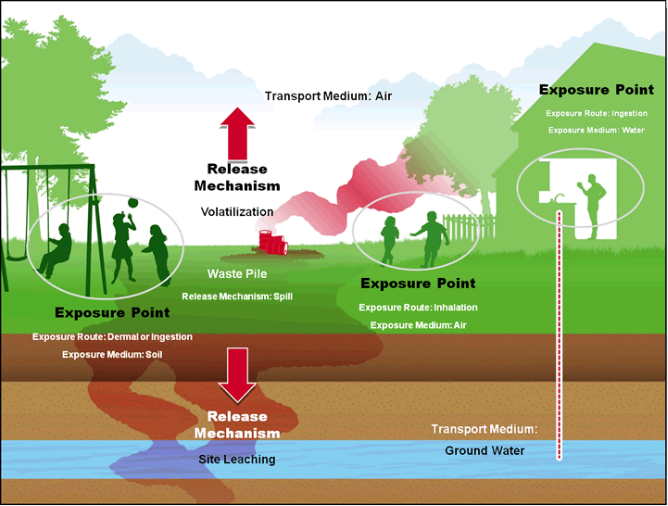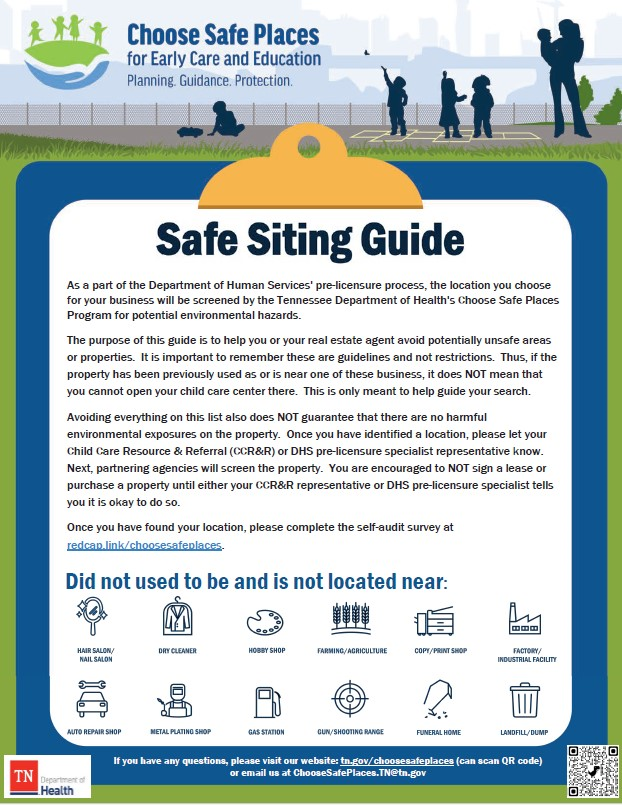Choose Safe Places: Safe Siting
Why is safe siting important for early care and education?
Chemical hazards expose people to dangerous substances which can cause the an increased risk of illness. Chemical hazards are often more serious threats for children. According to the Agency for Toxic Substances and Disease Registry (ATSDR), children are more likely to suffer from adverse health effects due to environmental exposure for several reasons, such as:
* Children's developing bodies can be particularly sensitive to toxic exposure during certain critical growth stages, especially when children are exposed to chemicals known to cause developmental effects.
* Children weigh less than adults. As a result, when children and adults ingest or inhale the same amount of chemicals, children receive a greater dose than adults.
* Because children play outdoors more than adults, they are often more likely to come into contact with contaminated soils and to inhale greater amounts of airborne pollutants.
How and what are the possible exposures?

This graphic from EPA shows how exposure can happen at an early care and education center. In this example, leaking drums in a waste pile are the source of chemical contamination. Chemicals are released from the leaking drums into the air by a process known as volatilization. Chemicals are released into the soil by leakage from the drums, and into water by the chemicals leaching from the soil. The chemicals can travel through the water to receptors, in this case children and staff, if the receptors drink from a contaminated well. Receptors can also be exposed by direct contact with the contaminated soil.
What does safe siting include?
Safe siting will look at facilities such as child care centers, day cares, preschools, nursery schools, and Head Start with these four criteria in mind:
1. former uses of the site that may have left behind harmful substances,
2. migration of harmful substances on to the site from other nearby sites,
3. manufacturing operations, or activities that may use hazardous chemicals,
4. the presence of naturally-occurring contamination; and access to safe drinking water.
It might not be possible to eliminate all exposures, but thoughtful consideration and mitigation of these four key elements helps to ensure that exposures to harmful substances do not reach unsafe levels.
When deciding whether to locate a child care center on a site known to have been used for other activities, consider the following:
* Prior activities on site that could have contaminated the inside of buildings on the property. Examples: manufacturing or funeral home.
* Contamination of the outdoor environment on the property, such as soil, surface water, or groundwater, from past activities on the site. Examples: auto crushing, residual pesticides from past farming.
* Prior use, storage, or disposal of potentially hazardous substances on site. Examples: a junk yard or dump site.
* Existing or former structures on the property that contain or once contained harmful substances. Examples: storage shed, underground storage tanks.
* Physical hazards. Examples: abandoned wells or debris.
* Potentially hazardous building materials in structures on the site. Examples: asbestos insulation, PCBs in light ballasts or caulk, lead-based paint.
* Use of contaminated fill on the site anytime in the past.
* Vapor intrusion of chemical contaminants in groundwater or soil from past activities on the site. Example: drycleaners.
Some nearby sites that might warrant attention include the following:
* Designated hazardous sites. Examples: National Priorities List (Superfund) site, state listed site, brownfields property, other hazardous waste site.
* Adjacent business, service, or facility that might release hazardous materials into the environment. Examples: auto repair, nail salon, agricultural pesticide use.
* Transportation infrastructure that could result in a greater risk of hazardous exposures. Examples: rail routes carrying harmful substances, transportation transfer points, trucking facilities.
* Threats posed by chemical contaminants migrating on-site via run-off, flooding, wind erosion, or vapor intrusion.
What is being done to ensure safe siting?
The focus of this initiative is licensed child care centers not located in private homes. Child care centers are generally located in commercial structures in non-residentially zoned (or mixed residentially zoned) areas. In contrast, family-based day cares are generally operated in homes in residentially-zoned areas. Thus, family-based day cares are less likely than child care centers to be located on properties with a past industrial use. Family-based day cares are also less likely to be located within the same building or immediately adjacent to an operating business, such as a nail salon or auto body shop, that could cause harmful exposures in the daycare.
What can I do to ensure my location is safe for children and employees?
* Review the history of your building.
If it was ever used for other purposes, such as a drycleaner or funeral home, check for chemicals or heavy metals. Former businesses or industries may have left behind invisible hazards in soil or dust.
* Take a look at your neighbors.
If you are sharing a strip mall with a drycleaner or nail salon, make sure you do not use the same air circulation system. Shared air could bring vapors or odors into your childcare facility.
For help evaluating your site, complete our self-audit survey to the best of your ability and return to the Tennessee Safe Places for Early Care and Education Program. You can download a copy here, or complete online.
If you would like to learn more about whether your site is a safe location for early care, contact us at ChooseSafePlaces.TN@tn.gov.
Additional resources
American Public Health Association (APHA)
Preventing Exposures through Safe Siting of Child Care Facilities: An ATSDR Initiative
apha.confex.com/apha/143am/webprogram/Paper337444.html
KidCentral TN
www.kidcentraltn.com/
ATSDR Choose Safe Places for Early Care and Education
www.atsdr.cdc.gov/safeplacesforECE/index.html
Connecticut Department of Health’s SAFER Program
www.ct.gov/dph/cwp/view.asp?a=3140&q=456216


